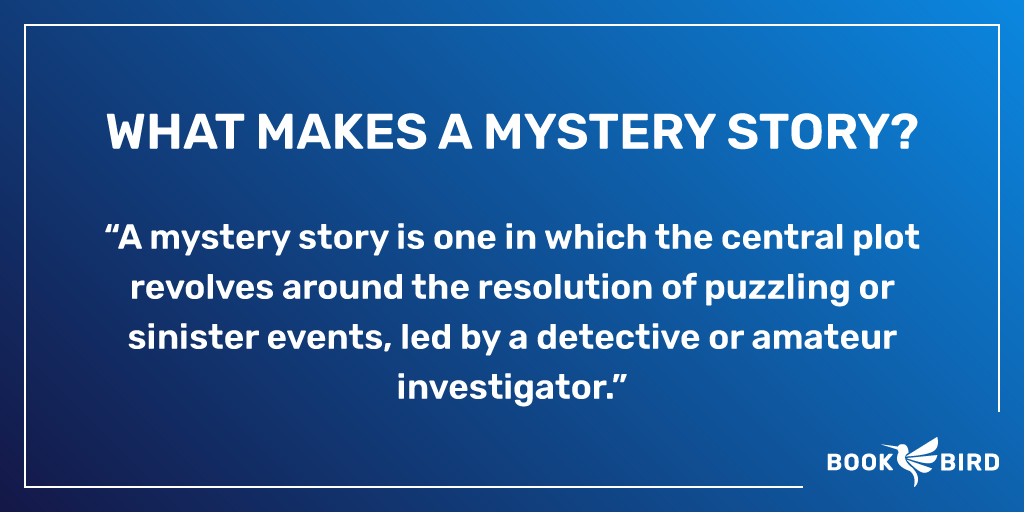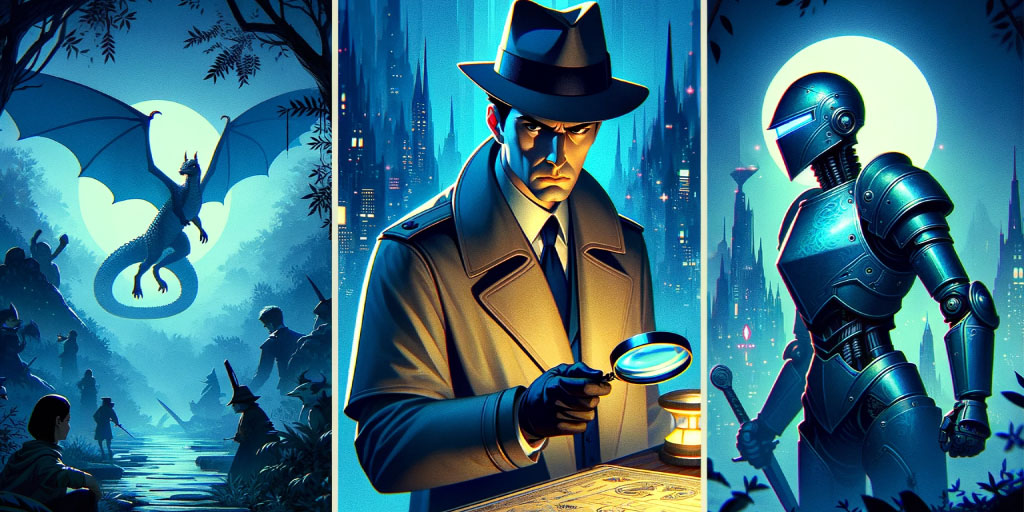Mystery stories have a unique allure, drawing readers into a world of crime, suspense, false clues, secrets, and intrigue. If it’s done well, they will imagine themselves in the sleuth’s footsteps, shrouded in a cloak of apprehension, unraveling the enigmatic clues that lead to a spine-tingling revelation.
But what makes a mystery story truly engaging, and how can you write one that will keep your readers guessing until the very end?
In this guide, we’ll share 12 powerful mystery writing tips that will show you how to write a mystery novel, transforming your storytelling process and leaving your readers eager to turn the pages, desperate to uncover the truth.
What Makes a Mystery Story?

Mystery is a genre that revolves around a puzzle that needs to be solved. This question can be a crime, but it can also be another type of mystery, such as a supernatural occurrence or a missing person.
These stories contain a central character who takes on the responsibility of unraveling the mystery and uncovering the truth. Readers are invited to follow the investigator’s thought processes, reasoning, and fact-finding methods as they diligently pursue leads, analyze evidence, and piece together the puzzle’s fragments.

To heighten the narrative tension, mystery stories usually employ elements of conflict, suspense and surprise. Authors reveal clues and evidence gradually, as well as introduce red herrings—misleading details or plot twists meant to divert attention away from the real villain or actual solution.
As the story progresses, readers become amateur detectives themselves, actively participating in the investigation by piecing together clues, speculating on motives, and attempting to solve the mystery before the characters do.
As such, this genre harnesses the innate human fascination with the unknown, the uncanny, and the insatiable curiosity to unearth hidden truths.
Literary Genre Quiz (Easy)

9 Types of Mystery Stories

Mystery stories come in various subgenres, each with its own unique elements and characteristics. Here are some of the different subgenres, along with descriptions of each.
1. Cozy Mystery
Cozy mysteries are known for their light-hearted and non-violent approach to crime-solving. They typically feature amateur detectives, often in a small-town or village setting, who solve crimes with wit, charm, and the help of their community. These mysteries emphasize the puzzle-solving aspect rather than graphic violence or suspense.
Some popular cozy mystery series include Agatha Christie’s Miss Marple series, Donna Andrews’s Meg Langslow novels, and Leslie Meier’s stories with reporter/investigator Lucy Stone.
2. Hard-Boiled Mystery
These unsentimental mysteries are gritty and realistic, featuring tough, cynical, and morally complex protagonists, often private investigators or police detectives. These stories delve into the darker aspects of crime and society, with a focus on urban settings, violence, moral ambiguity, and the bending of rules to solve cases.
Dashiell Hammett’s Sam Spade series, Raymond Chandler’s Philip Marlowe stories, and Ross Macdonald’s Lew Archer books represent this subgenre with aplomb.
3. Police Procedural
Police procedurals offer an in-depth look into the workings of law enforcement agencies. These stories emphasize the step-by-step investigation process, including interviews, forensic analysis, and legal procedures. Authors often research and accurately depict police work and criminal justice systems.
Here you will find Michael Connelly’s Harry Bosch series, Patricia Cornwell’s Kay Scarpetta forensic pathologist novels, and Tana French’s Dublin Murder Squad series.
4. Legal Mystery
This mystery type is centered on lawyers, prosecutors, or legal professionals who solve mysteries within the context of the courtroom or legal proceedings. These stories often involve complex legal dilemmas, courtroom drama, and ethical quandaries.
The most famous contributor to this subgenre is John Grisham, ably accompanied by Scott Turow, Steve Martini, and Richard North Patterson.
5. Medical Mystery
These science-focussed mysteries involve the investigation of perplexing medical cases, diseases, or outbreaks, often featuring healthcare professionals, medical detectives, or amateur sleuths who strive to uncover the underlying medical cause, solve medical puzzles, or prevent potential health crises.
Almost all Robin Cook and Michael Palmer books fall into this category, together with Leonard Goldberg’s Daughter of Sherlock Holmes series and Michael Crichton’s ” The Andromeda Strain”.
6. Historical Mystery
Historical mysteries are set in the past, often featuring a historical period, event, or figure as a backdrop. These stories provide readers with a sense of time and place while incorporating historical details and mysteries that fit within the chosen era.
In this subgenre, you will find Anne Perry’s Thomas Pitt novels situated in Victorian-era London, C.J. Sansom’s Matthew Shardlake series from the Tudor era, and Lindsey Davis’s Falco series set in ancient Rome.
7. Supernatural Mystery
Paranormal or supernatural mysteries incorporate elements of the paranormal, such as ghosts, vampires, or supernatural phenomena, into the mystery plot. These stories often blur the lines between the natural and the supernatural, creating an eerie and mysterious atmosphere and an unusual mystery that requires substantial out-of-the-box thinking to solve.
Some of the most famous authors include Shirley Jackson, Edgar Allan Poe, and Stephen King.
8. Whodunit Mystery
Whodunit mysteries, also known as classic or traditional mysteries, emphasize the puzzle aspect of the story. The central question is “Who committed the crime?” Readers are presented with clues and red herrings, and they are encouraged to solve the mystery alongside the investigator. The crime is usually a murder, and the protagonist is a detective who is trying to solve the case.
Here the classics are Agatha Christie’s Hercule Poirot series, Arthur Conan Doyle’s Sherlock Holmes books, and the Lord Peter Wimsey novels by Dorothy L. Sayers.
9. Psychological Mystery
Psychological thrillers, also often called psychological mysteries, blend elements of mystery and suspense with a focus on the psychological and emotional aspects of the characters. These stories usually involve unreliable narrators, mind games, and the exploration of the human psyche.
These books have been particularly popular since the turn of the century and include “Gone Girl” by Gillian Flynn, “The Girl on the Train” by Paula Hawkins, and classics like “Strangers on a Train” by Patricia Highsmith.
How to Write a Mystery Story

If you feel motivated to write your own mystery story but you feel like you need some guidance on the practical aspects of constructing one, this section provides a step-by-step guide on the art and craft of writing a mystery novel that will keep your readers eagerly turning the pages. So, let’s get started.
Step 1: Understand the Genre
By immersing yourself in the genre, you’ll become familiar with its conventions. This knowledge helps you create a story that resonates with readers who appreciate the specific characteristics of mysteries.
From cozy to supernatural mysteries, explore the subgenres so that you can choose the one that aligns with your writing style and interests. Knowing the nuances of each subgenre helps you tailor your story effectively.
While reading, analyze the structure of the novels. Identify common tropes and plot devices used in the genre. Consider how authors introduce clues, red herrings, and character motivations.
Take notes on what works well in the novels you enjoy. Pay attention to character development, pacing, dialogue, and how authors handle suspense and revelations.
Step 2: Craft a Mystery
While this step looks impossibly huge, you don’t have to work out all the details here. You can fill in much of it in later steps, so don’t feel overwhelmed.
But at least start by clearly defining the central mystery or crime that drives your story. This is the core puzzle that your protagonist will aim to solve. The mystery can be almost anything: murder, theft, missing persons, kidnapping, identity theft, sabotage, blackmail, cybercrime, a political conspiracy, a secret society/cult, or some other unexplained phenomenon.
Consider your own interests and passions. Writing about a mystery that fascinates you will make the storytelling process more enjoyable and authentic.
Real-life events, news stories, or historical incidents can serve as inspiration for your story. Adapt these events and add fictional elements to create a compelling narrative.
Use the “what if” technique to brainstorm potential mysteries. Start with a simple question like “What if a famous painting went missing?” or “What if a small-town librarian discovered an old diary with hidden secrets?”
Step 3: Develop a Backstory

Every crime or action to be investigated should have a motive. Why did the perpetrator commit it? The motive should be logical and compelling, providing a strong reason for the actions taken. Some possible motivations include the following:
- Greed: Greed or financial gain are powerful motivators for crimes like theft, embezzlement, fraud, and murder.
- Revenge: Revenge and personal vendettas can lead to crimes such as murder, blackmail, or acts of sabotage.
- Envy: Jealousy can drive individuals to commit stalking, harassment, or even violence against those perceived as rivals.
- Desperation: Dire circumstances like financial ruin, addiction, or a desperate need to protect loved ones may lead to criminal actions as a last resort.
- Power and Control: A desire for dominance and control over others can motivate crimes like kidnapping, human trafficking, or abusive behavior.
- Political or Ideological Beliefs: Some characters may commit crimes in the name of political or ideological beliefs, leading to acts of terrorism, espionage, or subversion.
- Love and Passion: Romantic or passionate relationships can lead to crimes of passion, including murder or acts of violence committed in the heat of the moment.
- Curiosity and Experimentation: Some mysteries may stem from characters’ curiosity, experimentation, or a desire to test boundaries, leading to unforeseen consequences. Think scientific experiment gone wrong, exploring forbidden areas, opening sealed containers, dabbling in occult rituals, AI experimentation, dark web exploration, etc.
Together with constructing a reason why the mysterious event happened, start thinking of the relationships your story will have to include to make sense of this reason. While you can develop your characters in depth later, describe the family dynamics, friendships, rivalries, or past connections that may have contributed to the events.
Step 4: Establish Clear Stakes
Define what’s at stake in the story. Why is solving the mystery important? What consequences will result if it remains unsolved?
Stakes give your protagonist a compelling motive to investigate the mystery. They also create tension and suspense, as characters race against time to unravel the mystery and prevent negative consequences. In short, they make readers care about the outcome.
The most immediate and high-stakes consequence of failing to solve a mystery is life or death. But such a failure can also lead to imprisonment, reputational damage, financial ruin, loss of valuable artifacts or knowledge, trauma, guilt, or danger to a community or political system.
Step 5: Create a Protagonist

Your detective or main character serves as the driving force behind the narrative, and their qualities, quirks, and motivations can greatly influence the reader’s engagement. Include the following in their profile:
- Characteristics: Consider unique physical traits, personality quirks, or habits that set your detective or protagonist apart from the typical investigator.
- Motivations: While you can include the stakes of investigative failures here, also describe personal or ethical reasons why your character wants or needs to solve the mystery.
- Backstory: Explore their past experiences, traumas, successes, and failures. Understanding their history will help you portray their motivations and vulnerabilities effectively.
- Flaws and Weaknesses: Introduce character flaws, weaknesses, or personal challenges that your detective or protagonist must overcome. Weaknesses that relate to the challenges they will confront are particularly appealing.
- Unique Skills or Expertise: If there is a particular profession, hobby, or talent that make your character well-suited for solving mysteries, describe them here.
- Character Growth Arc: Consider how your protagonist’s experiences throughout the story will shape them and lead to personal development.
Step 6: Create Supporting Characters
Populate your story with a cast of diverse and interesting characters, including potential suspects, witnesses, and allies for your investigator. Each character should have their own motives, secrets, and function in the story.
The allies will be people with unique skills, knowledge, or expertise that complement the protagonist’s abilities. They should have their own motivations for helping with the investigation. To make it interesting, you can also develop complex relationships between the protagonist and their aids in the form of conflicts or tensions that arise as the investigation progresses.
The potential suspects can be either heroes or villains, but should, by definition, not be the main character responsible for the crime or mystery. Consider these elements of suspects:
- Motives: Give each suspect a clear and distinctive motive for being involved in the mystery. These motives should be believable and provide a plausible reason for their potential involvement in the event.
- Backstories: Explore their personal histories and experiences to understand what drives them and what secrets they may be hiding.
- Alibis: Establish alibis for your suspects that can be investigated and verified by your protagonist. This will help you to construct clues and red herrings later.
- Relationships: Consider the relationships between suspects. Do they have alliances, rivalries, or conflicts with each other? These dynamics can create additional layers of intrigue.
Step 7: Build a Setting
Building a rich story setting is essential for immersing readers in your mystery and enhancing the overall atmosphere and believability of your narrative. A setting can be so suitable and well developed that it almost serves as another character.
Draw inspiration from real places, events, or settings that align particularly well with your narrative. For example, a snowed-in Victorian Mansion is a good place for a paranormal investigator to investigate a haunting, since they cannot simply leave when events become too scary.
Sherlock Holmes did this particularly well in his Arthur Conan Doyle stories, where the foggy and atmospheric streets of Victorian-era London with their ancient alleyways, echoing footfalls, and glimpses of silhouettes contribute to the sense of menace and intrigue in the stories.
Alternatively, you can pick a setting that contrasts with your mystery in a way that is memorable in some way. In “Death on the Nile,” for example, Agatha Christie transports readers to the beautiful, exotic, and romantic setting of a luxurious riverboat on Egypt’s Nile River, where a murder mystery soon develops.
Engage readers’ senses by describing sights, sounds, smells, textures, and even tastes that characterize the environment.
Step 8: Craft Clues and Red Herrings
Layering clues and red herrings is a crucial step in crafting a captivating mystery story. Clues propel the investigation forward and guide readers closer to the truth, while red herrings are false leads designed to misdirect and create suspense.
Clue vs. Red Herring
If a detective finds a hidden compartment in a suspect’s desk containing a photograph of the victim and an old love letter, it can either be a clue or a red herring, as follows:
Clue: The suspect had a romantic relationship with the victim, potentially leading to a motive for the murder.
Red Herring: The photograph and love letter were planted by someone else to frame the suspect, diverting attention from the real culprit.
Crafting Clues and Red Herrings
To craft good clues and red herrings, keep these factors in mind:
- Core Clues: Identify the core clues that are essential for solving the mystery. These are the pieces of information that, when combined, lead to the ultimate solution. These clues should be logically connected and scattered throughout the story to help readers solve the mystery, but avoid introducing them too early.
- Red Herring Opportunities: Look for opportunities to introduce distractions, misdirection’s, or false leads that divert the protagonist and reader away from the true solution. Avoid using more than two of three simultaneously, as readers will then not notice them.
- Character Motives: Consider the motives of characters, including potential suspects, witnesses, and allies. What reasons might they have to provide false information or create deceptive situations? Align red herrings with character motivations.
- Progressive Revelation: Start with minor or subtle clue hints and progressively escalate to more significant revelations. This builds suspense and maintains reader interest.
- Character Involvement: Involve characters actively in the discovery of clues and red herrings. Allow them to interpret and react to the information they encounter, deepening their engagement in the mystery.
- Balanced Revelations: Ensure that genuine clues and red herrings are revealed in a balanced manner. Avoid having a long stretch of the story with only one type of revelation. Mix genuine progress with moments of misdirection.
- Seamless Integration: Incorporate both types of lead naturally into the narrative. They should arise from character interactions, evidence, dialogue, or the environment. Avoid making them too obvious or contrived.
- Clue Variety: Use different types of clues and red herrings to keep the mystery engaging. These can include physical evidence (e.g., a bloodstained shirt), verbal hints (e.g., a cryptic message), or character behavior (e.g., an unexplained absence).
- Foreshadowing: Foreshadow major clues with subtle hints or references earlier in the story. Foreshadowing helps make the ultimate reveal feel earned and logical.
Step 9: Plan the Investigation

Now that you’ve specified the potential suspects, the clues, and the red herrings, you can plan the protagonist’s investigation. Much of it will fall into place with the insertion of the details in the previous steps, so a good approach is to develop a timeline or chronology of events related to the mystery to lead your protagonist down a logical investigative path.
Decide when your protagonist will stumble onto the clues and red herrings. At the beginning, they will probably encounter more false than real clues. Once they eliminate these, the clues will start playing a bigger role in their investigations and their thinking.
Establish how they will encounter the information that feeds into their investigations. Physical evidence, witness testimonies, research, undercover investigations, anonymous tips, characters’ suspicious behavior, coincidentally crossing paths with a suspect, the noticing of patterns, or any other method can work.
Step 10: Build Suspense and Tension
The stakes you identified in a previous step will help you to build tension, but you can also use other methods to convey a sense of urgency that propels the investigation forward. Time constraints, impending danger, or impending consequences can intensify tension and keep readers on edge.
Control the pace at which you reveal information. Gradually disclose clues, red herrings, and key revelations throughout the story. Avoid overloading the reader with too much information at once, as this will lead to wildly exciting periods interspersed with long, tedious parts.
Foreshadowing allows you to hint at future developments and create an atmosphere of anticipation. Drop subtle clues or suggestions about what’s to come, leaving readers eager to see how these hints will play out.
Use the setting and conflicts between the investigators and/or the suspects to build further tension.
Another way to prevent readers from getting bored is to include emotionally charged scenes that resonate. These scenes can involve personal revelations, confrontations, or high-stakes confrontations with suspects or adversaries.
Step 11: Write a Satisfying Resolution
This is the culmination of your mystery story, where the central mystery is solved, loose ends are tied up, and the reader experiences a sense of closure and fulfillment.
The resolution should unveil the truth behind the mystery in a gradual and logical manner. Avoid a sudden, last-minute revelation that feels contrived. Instead, let the protagonist piece together the final clues and deductions.
A good way is to orchestrate a confrontation between the protagonist and the culprit or key players involved in the mystery. This showdown can be emotionally charged and provide the outstanding answers.
Ensure that the resolution is plausible and consistent with the clues and information provided throughout the story. Readers should be able to look back and see how the solution was seeded throughout the narrative.
The resolution should explain why the crime or event occurred, who was responsible, and how it was carried out. Provide a clear understanding of the “whys” and “hows.”
Show the impact of the resolution on the characters, particularly the protagonist. Allow them to experience growth, closure, or transformation as a result of solving the mystery. Address any personal stakes introduced earlier in the story.
If your story has a theme, use the resolution to reflect and reinforce it. The resolution can offer insights or lessons related to justice, morality, or the human condition.
Step 12: Revise Your Story
Read through your story to examine it for plot holes, inconsistencies, contrived plot points, character depth, inappropriate pacing, and the incorrect placement and effectiveness of clues and red herrings.
You should ideally hand copies to friends, relatives, and beta readers who enjoy mystery fiction. Readers who read regularly in this genre will be able to help you identify tropes, clues, and investigative details to improve.
Based on these insights, revise your story until it is ready for professional review.
8 Common Pitfalls to Avoid in Mystery Writing

Even the most experienced mystery writers employ editors to delete their cliches, close their plot holes, and fix their logical inconsistencies. There are certain traps that beckon all mystery writers, so it’s important to be aware of them if you want to write a mystery story that is polished and professional.
Here are some common pitfalls to avoid in mystery writing:
1. Too Easy to Solve
One of the biggest pitfalls that mystery writers can make is making the mystery too easy to solve. If the reader can figure out the solution to the mystery too early on, they will be bored and disappointed.
To avoid this pitfall, make sure that you plant enough clues throughout your story, but don’t make it too easy for the reader to figure out the solution. Use red herrings to misdirect the reader and keep them guessing until the very end.
2. Too Difficult to Solve
While mysteries often involve intricate plots, avoid making them overly convoluted or completely impossible to solve. If the reader can’t figure out at least potential solutions to the mystery, they will be frustrated and confused.
To get around this pitfall, make sure that you give the reader enough information to solve the mystery, but without giving everything away. Leave some of the clues up to the reader to interpret.
3. Too Few Potential Suspects
Readers of mystery stories know that the main villain is usually someone who seems likeable and is a good friend of the protagonist. So, if you have only one or two such characters in your story, it will be far too easy for readers to identify the villain.
Accordingly, make sure that there are enough suspects who are basically likeable, at least until seventy percent through the story.
4. Predictable Ending
A mystery with a predictable ending can be disappointing. Strive for a resolution that surprises and satisfies readers, even if they’ve made some correct guesses along the way.
In other words, even if readers can predict the villain, make sure that the motivations for their crimes or the details of how they committed them are surprising.
5. A Deus Ex Machina Ending
A Deus Ex Machina ending is an ending that is resolved by a sudden, unlikely, or unexplained event that is not foreshadowed or explained in the story. It can make the ending feel unsatisfying, unrealistic, and like a cheat.
You can avoid this by making sure that your ending stems from something that has gone before in the story. You should write the story in such a way that the reader has all the information they need to understand the solution to the mystery.
6. Overuse of Coincidences
Coincidences can sometimes be useful, but not if your protagonist coincidentally stumbles onto most of the clues they need to solve the mystery. Your readers want to believe that the mystery is resolved through your protagonist’s efforts and intelligence.
Consequently, try to minimize coincidences or, if necessary, provide a plausible explanation for them.
7. Neglecting Character Development
Well-developed characters are essential in any genre, but they’re especially important in mysteries. Avoid creating one-dimensional characters solely driven by the plot. Readers should care about what happens to them.
Formulate backstories, motivations, and personalities for the more important characters.
8. Too Many Red Herrings
While red herrings can add intrigue, using too many can overwhelm readers and make the story feel contrived.
Make sure each red herring serves a purpose in the narrative. It has to lead to a potential suspect or a direction for the investigation.
Literary Genre Quiz (Hard)

Frequently Asked Questions
In this section, we will answer some of the most common questions about the definition and characteristics of mystery stories.
What Defines a Mystery Story?
A mystery story is a narrative that revolves around an enigma, puzzle, or unresolved question, typically involving a crime or unusual event. It engages readers by presenting a central mystery that propels the plot, characters, and readers on a quest for answers, often leading to a successful investigation and resolution of the mysterious event.
What Are the Elements of a Mystery Story?
A mystery story has a central puzzle that needs to be solved, a protagonist who is trying to solve it, clues that are scattered throughout the story, red herrings that mislead the reader, often a climax in which the protagonist and antagonist confront each other, and a resolution in which the mystery is solved.
What Are Popular Mystery Story Examples?
Popular mystery story examples include iconic works like Sir Arthur Conan Doyle’s Sherlock Holmes series, featuring the brilliant detective Sherlock Holmes and his loyal friend Dr. Watson solving complex cases; Agatha Christie’s Hercule Poirot and Miss Marple series, renowned for their intricate plots and memorable characters; Dashiell Hammett’s “The Maltese Falcon,” in which a hard-boiled private detective solves a case involving a priceless statue, greed, and murder; and modern mysteries like Gillian Flynn’s “Gone Girl,” celebrated for its psychological twists and unreliable narrators.
Final Thoughts
To write a good mystery story, remember that a compelling central mystery is at the heart of it all. Engage your readers with a tantalizing puzzle that invites them to participate in the unraveling. Develop characters that feel real, with motives that drive their actions and reactions. Master the art of suspense, using carefully placed clues, red herrings, and plot twists to keep your audience guessing.
But above all, never forget that crafting a good mystery is not just about the destination but the journey itself. Embrace the challenge, let your creativity flow, and may your stories be the kind that readers can’t put down!







